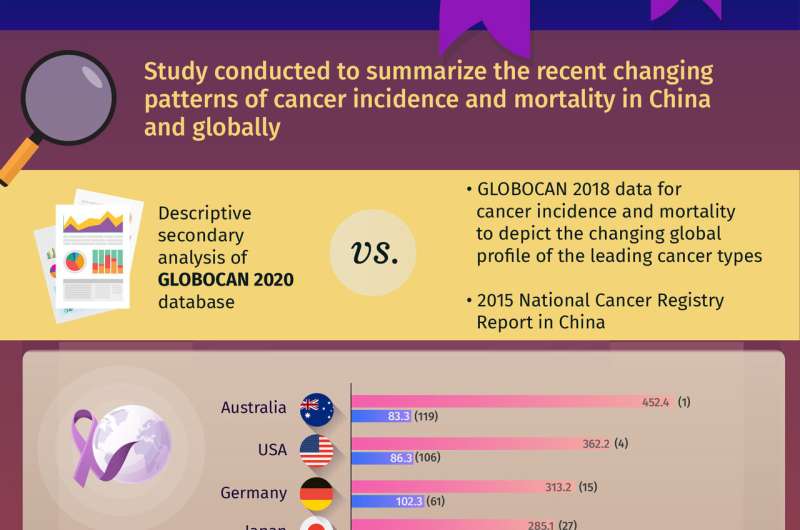Mapping the paradigm shift of China’s cancer burden for designing prevention strategies


Cancer is one of the top causes of death worldwide. The cancer burden is related not only to genetic predisposition, but also to environmental pollution and socioeconomic factors such as lifestyle. Consequently, the burden of this disease is not uniform across all countries. In fact, the public health of China, a country known for the rapid change in its development status in the last few decades, has undergone a paradigm shift with respect to cancer incidence and mortality.
To better understand the cancer burden of the country, a team of researchers from Chinese Academy of Medical Sciences and Peking Union Medical College reviewed the data of GLOBOCAN 2020, an online database of cancer incidence and mortality compiled by the International Agency for Research on Cancer. They then compared the data for 2020 with that for 2018. “The trajectory of country-specific cancer trend is complex, and given the heterogeneity in social and demographical context, a ‘one-size-fits-all’ recipe would not work,” says lead researcher Dr. Wanqing Chen of the Chinese Academy of Medical Sciences and Peking Union Medical College, China. The findings of Dr. Chen’s team have been published recently in the Chinese Medical Journal.
Their investigation into how the ranks of 14 leading types of cancer—based on the number of new cancer cases and deaths—changed globally revealed that in 2020, breast cancer surpassed lung cancer to become the most frequently diagnosed cancer. The reasons for this rise may include increasing obesity or changing reproductive practices. While lung, liver, stomach, breast, and colon cancers were found to be the top five leading causes of cancer-related death, interestingly, the cases of stomach cancer showed a notable reduction.
The comparative assessment of the cancer incidence and mortality of 185 countries revealed some intriguing facts about the unique cancer scenario of China. It highlighted that 24% of all newly diagnosed cases and 30% of the cancer-related deaths in the world were reported from China. The high incidence of cancer might be partially attributed to the vast population of the country. The country-wise assessment of the age-standardized incidence rate (ASIR) and age-standardized mortality rate (ASMR) further emphasized the severity of the cancer burden in China. Well above the global average, the high ASIR (204.8 per 100,000) and ASMR (129.4 per 100,000) of the country made it rank 65th and 13th in these categories, respectively. Strikingly, Japan and Korea, both China’s neighboring countries, had higher ASIRs but lower ASMRs than China.
The gender-wise distribution of the most common cancer types in China painted a different picture. Among Chinese men, lung cancer was the most common cancer type, accounting for 38% of the global lung cancer cases in men. In contrast, following the global trend, breast cancer was the most common cancer type in Chinese women, accounting for 18% of global cases. However, lung cancer remained the leading cause of cancer-related deaths in both sexes in China, covering 40% of global lung cancer deaths.
Gastrointestinal cancers, including stomach, colorectal, liver, and esophageal cancers, also contributed to high incidence and mortality. Among Chinese males, gastrointestinal cancer ranked in the top five common cancer types after lung cancer and accounted for 47% of global gastrointestinal cancer deaths. Accounting for 38% of global new cases, thyroid cancer ranked as ninth and fourth in the list of most common types of cancer among men and women, respectively.
Going by the current trend of the global cancer burden, the researchers depict a grim future as the incidence and mortality due to cancer will continue to increase over the next 20 years, with a relatively high magnitude in Asia. With an already high cancer mortality rate, along with a predicted 6.85 million new cancer cases and 5.07 million deaths in 2040, China is in urgent need of targeted intervention for cancer control.
However, Dr. Chen is hopeful that dissemination of knowledge on China’s cancer epidemiology would help to raise public awareness of cancer risk and promote a healthier lifestyle. He surmises, “An overview of the updated national cancer epidemiology will help renew our understanding of the recent cancer burden. Comprehensive strategies, including health education, dissemination of essential knowledge about cancer, advocating healthy lifestyles, effective screening, vaccination programs, and tobacco-control policies need to be customized to target China’s cancer burden.”
Source: Read Full Article




